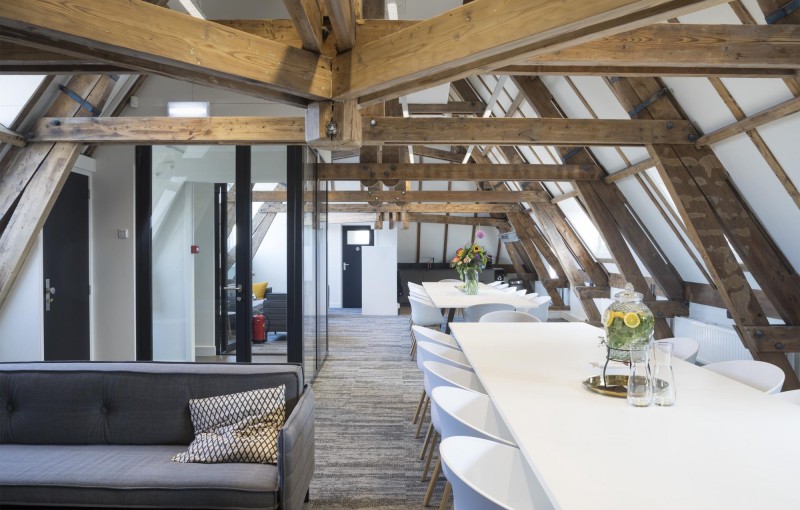
Strategic advantages of hybrid work: the economic and organizational revolution
✔Last updated: November 2025, by Jeroen van der Linde

The stage where hybrid work was merely a trend is long behind us. It has become a structural shift in the organization of labor. The modern form of hybrid work represents the optimal synthesis of the traditional office and remote work, placing the employee at the center. For organizations moving toward mature hybrid work, this results in strategic advantages in recruitment, finance, and productivity. However, these strategic benefits require a fundamental rethinking of office space, with the traditional real estate model giving way to agile solutions.
Rent office space with Flexas.com
In-depth benefits for people and organizations
The impact of hybrid work extends across the entire organization. The benefits are mutual: more flexibility for employees translates into measurable results for employers.
Sustainable workplace happiness and combating burnout
The most significant benefit of flexibility is the improvement of work-life balance and the mental resilience of employees. The option to structure the day freely, for example by fitting in a workout or picking up children from school, reduces the feeling of constant time pressure. Eliminating daily commute time (‘commuting costs’) reduces stress and gives employees valuable hours back. Research shows that employees with a good work-life balance are not only happier but also take fewer sick days and are less likely to become emotionally exhausted. 76% cite an improved work-life balance as the biggest advantage, and 61% report experiencing less burnout or fatigue at work thanks to hybrid work (Gallup, 2025). This directly translates into lower absenteeism costs and a more engaged workforce.
Optimized productivity: deep work versus collaboration
Hybrid working makes it possible to choose the work environment that best fits the nature of the task. This is the true engine behind productivity gains. Tasks that require uninterrupted concentration (deep work), such as complex analysis, programming, or writing strategic documents, are often performed more efficiently at home because employees can avoid social distractions and superficial interruptions typical of office environments. Conversely, tasks that rely on spontaneous interaction, non-verbal cues, and quick alignment (brainstorming, onboarding, crisis meetings) remain essential for the office. Productivity gains are achieved because employees spend their office time on high-value interaction, while using their home time for focused work. Freedom of choice in work environment is the primary driver.
Substantial cost savings through real estate strategy
The financial benefits for employers are substantial, particularly through more efficient use of office space. Reduced physical presence results in lower facility costs such as energy, catering, and cleaning. PwC’s estimate of a total annual cost saving of €1.7 billion in the Netherlands highlights the economic potential of the model. By introducing flex desks and repurposing space, the required floor area (vvo) can be reduced. Savings in rental and depreciation costs are the largest financial lever of hybrid working. This forces organizations into strategic real estate decisions: transforming or reducing the size of the office.
Maximum appeal in the labor market
In a tight labor market, flexibility has become a crucial selection criterion. By discarding the requirement for daily physical presence, organizations can expand their recruitment radius. This enables them to attract talent that does not live nearby or who, for personal reasons (care duties, long commute), requires a high degree of flexibility. Hybrid working is now a hygiene factor: employers who do not offer it miss out on a significant portion of the talent pool and increase the risk of turnover.
The transformation of the office: from workplace to destination
The office is undergoing a metamorphosis from a mandatory workplace to a strategic destination or ‘clubhouse’ that gives employees a reason to come in. The old office layout, with 70% individual desks, is no longer functional for everyone. The new distribution of roughly 40% individual workspaces and 60% meeting and collaboration areas is a strong solution. That 60% is now filled with specific zones such as small enclosed focus and call rooms for online meetings and deep work. In addition, there are comfortable lounge-like environments—the so-called “clubhouse” zones—that encourage relaxed and spontaneous interaction. Finally, project rooms are created: flexible spaces where teams can come together physically for several days or weeks for intensive projects. This redesign ensures that when employees come to the office, they get maximum value from in-person interaction, strengthening social bonds and innovation. The office thus becomes the anchor point of company culture.
Challenges and the need for equitable hybrid policies
The success of hybrid work depends on thorough and thoughtful policies that counter inherent pitfalls.
The danger of proximity bias
‘Proximity bias’ is the tendency for managers to view employees they see more often (in the office) as more productive and more engaged, leading to unintentional inequality in opportunities, project assignments, and promotions. Organizations must shift from leadership based on perceived presence (input) to leadership that measures results and output. Managers must actively ensure that remote workers have the same access to information and managerial attention as in-office workers—crucial for preventing a ‘two-class’ system.
Social cohesion and the digital divide
The decline in informal, spontaneous social interaction (at the coffee machine) is a real risk. This can be compensated for with deliberately planned ‘team-building days’ instead of merely office days. This means organizing social events, shared lunches, or workshops to preserve the emotional connection essential for a strong company culture and mutual trust.
Concrete steps for a successful hybrid policy
A successful transition to hybrid work requires a structured policy that goes beyond merely determining the number of office days. First, it is essential to determine the ‘why’ of the office by defining for each team or department whether the office serves as a place for collaboration, culture, or concentration. This prevents employees from coming to the office for tasks they could perform better at home. Next, rhythms must be established by communicating clear expectations about the number of office days (for example 2 to 3 days) and the core moments when teams are required to meet. These moments are focused on team alignment, innovation, and social cohesion—not individual work.
In addition, it is crucial to invest in home-working provisions by offering a home office allowance or providing essential IT equipment (second monitor, ergonomic chair). This is vital for employee productivity and well-being, and for complying with occupational health regulations. Managers must be trained to avoid proximity bias by evaluating based on results rather than monitoring presence.
Quantifying cost savings: the models
The transition from the unstructured phase of fully remote work to a structured hybrid model provides organizations with significant and manageable financial benefits. While fully remote work introduced risks related to social cohesion and unpredictable home-office support costs, the return to the office (via flexible space) restores financial control and productivity gains.
The desk divestment model and the OpEx shift
This model delivers the largest immediate savings by eliminating the need for large, long-term real estate investments—a requirement questioned during the fully remote phase. The shift from fully remote to hybrid work enables controlled desk reduction. The organization gains by avoiding long-term risks and fixed costs (CapEx) associated with traditional office leases. Instead, payment is made only for the required capacity through flexible office space (OpEx). This model provides maximum agility: one pays only for the needed space, delivering direct savings in rental and depreciation costs compared to maintaining unused fixed office space.
Financial control and the shift in operational costs
During the period of fully remote work, many organizations faced unpredictable costs related to supporting hundreds of individual home office setups (IT support, allowances, ergonomics). The transition to a structured hybrid model—especially when using flexible offices—restores financial control. Organizations pay a fixed, transparent fee per user for an all-inclusive service. This eliminates the variability of individual home-office allowances and the administrative burden of fragmented facility costs (such as energy and cleaning), which are often already included in service fees. The benefit lies in cost predictability: uncertain variable costs are transformed into predictable, scalable service costs, greatly simplifying budgeting.
Productivity gains through social cohesion
The most crucial financial benefit of hybrid work is regaining the lost productivity and cohesion of the fully remote phase. While long-term remote work led to isolation and increased burnout risk, the hybrid model restores the high-quality interaction essential for innovation and knowledge sharing. The combination of uninterrupted deep work at home and high-quality collaboration in the office can produce a productivity increase of 5–10% (Nicholas Bloom, 2024). Moreover, improved social cohesion and higher employee satisfaction—driven by a better work-life balance—directly translate to lower recruitment costs. Better retention reduces the need for costly and time-consuming recruitment. Steering actively toward a return to the office through a flexible model is therefore a direct investment in human capital and long-term financial return.
Flexas.com is the partner in finding the ideal hybrid workplace
Hybrid work is the fundamental building block of a resilient and competitive organization. It has permanently transformed the role of the office from a mandatory workplace into a strategic destination. Choosing the right physical environment is key to realizing the full productivity benefits and better work-life balance for employees, because it facilitates the high-quality collaboration that fuels innovation and culture. Finding the ideal office space that meets these new dynamic requirements and fits your budget and ambitions requires specialized expertise. Flexas.com is the partner that guides you in finding the perfect flexible office environment where your hybrid policy can fully thrive.
Rent office space with Flexas.com Start your search
Sources:
Gallup: The Remote Work Paradox: Higher Engagement, Lower Wellbeing
PwC: An extra day of working from home yields nearly 4 billion euros for society


